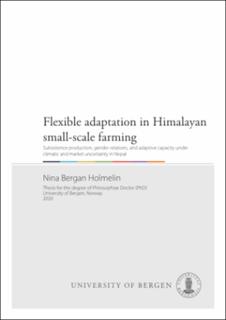| dc.description.abstract | Climate change imposes new challenges for small-scale farmers in Nepal by adding climatic uncertainty to the existing natural climate variability, and by disturbing food production systems and food markets. In conjunction with a fluctuating international labour market with low job security for unskilled migrant workers, it is likely that local, subsistence-based food production will continue to be important for household food security in rural Nepal.
This dissertation studies the adaptive capacity of a small-scale farming community through the theoretical lens of flexibility. Building on Gregory Bateson’s notion of flexibility as uncommitted potentialities for change, I argue that buffers of unused capacity in factors of production, opportunities for change in crop composition, and the ability to rapidly adjust production give room to manoeuvre. Flexibility in farming gives capacity to adapt to increasingly unpredictable fluctuations in local climatic conditions and international markets for food and labour.
By conducting ethnographic fieldwork and applying qualitative and quantitative fieldwork methods to a case study from the Nepali Middle Hills, I analyse flexibility at the scales of a community farming system and household farm systems. Here, as elsewhere in Nepal, foreign labour migration by young men is prevalent. However, migrants have also started to return and invest their labour in new cash crops, which add to the households’ cultivation of traditional staple crops for food. Since land holdings are small and few are fully self-sufficient from own production, additional food is bought by means of some income from cash cropping, remittances, and off-farm work. The expansion of the local range of available cultivars enables farmers to alternate between various food and cash crops, and ensures that if one crop fails, there are others to eat. Diversification, not specialization, preserves the flexibility to rapidly adjust resource utilization, crop compositions, and productive practices. A flexible combination of subsistence production and high-value crops makes an important contribution to adaptive capacity under uncertain and variable climatic and market conditions.
Migration has contributed to raise household incomes through remittances but has also increased the agricultural work burden for women. Although women already take part in decision-making on the farm, their participation in public, financial and market spheres are more restricted. Local gender roles are currently changing as women have started to enter new social spheres. I find that there are two competing sets of cultural gender norms in Nepal: Modern development ideas of women’s empowerment and gender equality challenge traditional gender norms, which constrain women’s decision-making power to the household and the farm. In the local community, the ability to negotiate a new role space for women is socially differentiated. Individuals who stand strong in hierarchies of caste and ethnicity, wealth, age, and marital status are in a better position to change local gender roles than less fortunate individuals who rather feel caught in a cultural conflict of competing gender norms. In sum, cultural change in local gender roles opens for greater participation by women in public life, local markets, and microcredit cooperatives.
Although income from cash cropping is an attractive option for returned migrants, the households’ production strategy is not primarily driven by a desire to maximise profit. Cash cropping is considered a high-risk option and an alternative to migration, but not an alternative to subsistence food production. I find that people combine two production logics: They apply the profit-motivated market logic on a small share of their land, while keeping most of their land for food production for own consumption. According to the subsistence logic, the main purpose of farming is to ensure a stable access to food for the household by means of own production, to contribute to and benefit from reciprocity-based systems for sharing food and labour in the community, and to maintain social ties and traditions.
The current agricultural development strategy of the Nepali Government regards subsistence production as an impediment to economic growth, and advocates a transformation of Nepali agriculture into large-scale, mechanized, specialized, and commercial production units. Implementing this strategy may improve the agricultural sector’s economic performance and reduce Nepal’s dependency on food imports, but it would not ensure stable access to food for rural farming households. The farmers’ strategy to balance subsistence and market production, and maintain social security systems in the community, enhances their food security and adaptive capacity.
Theoretically, I distinguish between two levels of abstraction and argue that in a dynamic and uncertain environment, flexible adaptation at one level of abstraction helps ensure the general sustainability of the system at a higher level. Ensuring the sustainability of small-scale farm systems means to maintain their ability to provide people with food and a livelihood, often in combination with off-farm activities. Unless national policies that severely restrict the farmers’ flexibility are implemented, or the impacts of climate change turn out to exceed the limits of adaptive capacity in this community, small-scale subsistence farming is likely to persist in Maina Pokhari. | eng |
| dc.relation.haspart | Paper I: Holmelin, Nina and Aase, Tor H. (2013). Flexibility of Scope, Type and Temporality in Mustang, Nepal. Opportunities for Adaptation in a Farming System Facing Climatic and Market Uncertainty. Sustainability 2013, 5(4),1387-1405. The article is available in the main thesis. The article is also available at: <a href="https://doi.org/10.3390/su5041387" target="blank">https://doi.org/10.3390/su5041387</a> | eng |
